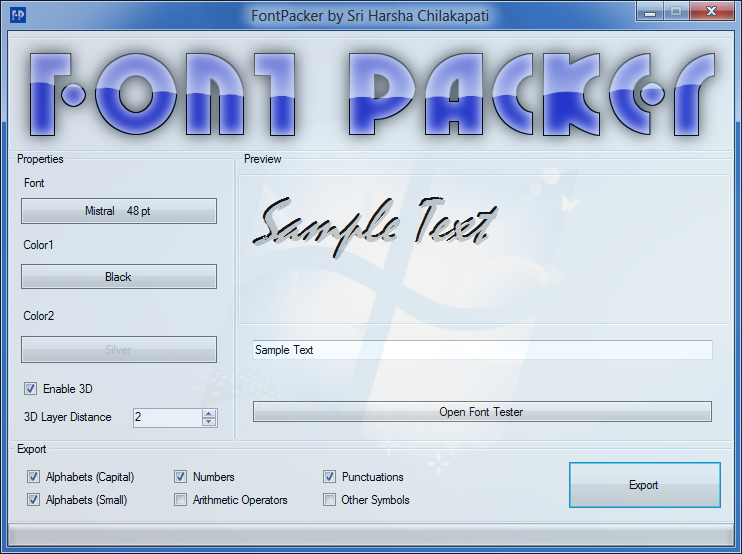This is my first productive application in C#. It allows to export specific truetype font into a folder with different colors and sizes as bitmaps. Exports the selected glyphs in PNG format so that they can be used in OpenGL games. Here’s the screen shot.
GitHub
SriHarshaChilakapati/FontPacker
WebSite (Downloads)
Transfer2pc.weebly.com/FontPacker.html
[h2]Using the Fonts[/h2]
After you create a [icode].fntpack[/icode] file, you need to use it as XML. Here’s the structure of the file.
The xml file starts normally with the xml declaration. Then comes the root tag [icode][/icode] which contains the [icode][/icode] tag with an attribute [icode]name[/icode].
<Font name="Microsoft Sans Serif"> ... </Font>
Then comes the [icode]Glyph[/icode] tags in the font tag with the following attributes.
- [icode]char [/icode] - The character value
- [icode]data [/icode] - The Base64 encoded PNG image of that glyph
- [icode]xadvance [/icode] - The pixels to move forward after drawing that glyph
Here’s an example overview.
<?xml version="1.0" encoding="utf-8"?>
<FontPacker>
<Font name="Microsoft Sans Serif">
<Glyph char="A"
data="....Base64 encoded PNG image here..."
xadvance="33" />
<Glyph char="B"
data="....Base64 encoded PNG image here..."
xadvance="30" />
</Font>
</FontPacker>
The XML files have no indentation which is included in this sample. When using in C#, you can use the pre-made FontPack library available in the git and in binaries.
[h2]Changes[/h2]
- Added progress bar and font tester
- Fixed the packer to give correct values for xadvance
- Fixed the glyph width measuring algorithm
- Supports Italic Fonts and Script fonts





